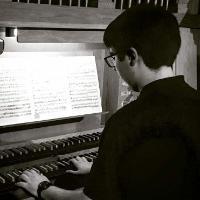All Activity
- Past hour
-

Jouskas (looking for feedback)
Uhor replied to Fruit hunter's topic in Orchestral and Large Ensemble
I'm a fan of the quiet bits too. For an entire course on how to incorporate both calm and disruptive writing there's Boulez's Notations for Orchestra VII, I highly recommend it. -

And then I realised - Large Orchestra + SATB Choir
Uhor replied to Symphonic's topic in Orchestral and Large Ensemble
I'm enjoying it quite a bit. I hear early John Adams. -
elmarad40 started following Dance Of The Moonlit Clouds (Piano solo)
-
Hi everyone, This is my latest piano composition, dance of the moonlit clouds. I believe it has influences like classical and more modern piano music. I could describe this track as: A night scene with the clouds dancing under the moonlight, carried away by the wind...enjoy! You can listen to it here: Dance Of The Moonlit Clouds I have also added the pdf score to this post. Thank you!
- Today
-
JordiHortal started following Fantasia sobre un tema de J. S. Bach
-

bach Fantasia sobre un tema de J. S. Bach
JordiHortal posted a topic in Orchestral and Large Ensemble
I’m excited to share with you what is, quite possibly, the most ambitious and elaborate work I’ve composed so far. As the title suggests, it’s an orchestral piece based on Bach’s Little Fugue in G minor (BWV 578). As an organist, this piece has had a profound impact on me throughout my years of study and has always been a reference point—both in terms of performance and musical analysis. Let me briefly explain a few key aspects of the work: - The first instrument to present the theme is the oboe. This was not a random choice: I wanted to pay tribute to Stokowski’s orchestral version of the fugue, in which the oboe also introduces the main theme. - The second section (bar 16) opens with the chord progression from the end of Bach’s fugue, making the connection even more evident if it wasn’t already. This part showcases a reharmonized version of the main theme, which remains ever-present throughout. Some passages directly quote Bach’s fugue, such as bars 39 to 44, where I’ve preserved the original texture of three or four voices. - The third section (bar 70) brings a strong contrast. After a short bridge that shifts to the major key, I introduce a kind of string quartet based on the opening notes of the original fugue. I like to think of it as a chorale harmonization in the spirit of Bach (though not in his actual style), which eventually leads to a climax in bar 95, where the fugue theme reappears in the major key, accompanied by multiple counter-melodies. - No piece based on Bach would be complete without at least a small reference to a fugue—so I decided to end the work with one. The subject of this final fugue is “original” (in quotation marks because it is inspired by something, but I’ll leave the source as a mystery for now—you’re welcome to try and figure it out!). - From bar 126 onwards, the beginning of Bach’s original fugue returns briefly within my own, setting up a kind of “battle” between the two fugue subjects. In the end, Bach’s fugue emerges victorious, and the piece culminates similarly to Stokowski’s version, with the fugue theme resounding in the low brass and trumpets. The only real change I’ve made is in the final three bars, which conceal (though not very subtly) a musical signature of someone—which again, I’ll leave for you to guess. I truly hope you enjoy listening to the piece as much as I enjoyed composing it. This time, I’d especially love to hear your thoughts and feedback, as I’ve been given the opportunity to premiere it with an orchestra I belong to. I want to make sure everything is perfect—musically, but also in terms of notation and the overall score—before bringing it to the stage. Many thanks for the opportunity! -
A vast improvement over my technique up until this point. A sample:
-
Henry Ng Tsz Kiu started following Symphony No.1 - Second Movement
-
So I've been getting creative again and have spent days working on this, still needs to grow and be a lot more polished but it has been fun so far. Warning: loudness
-
.thumb.png.8b5b433a341551e913a34392660bc95b.png)
Simulation Level
PeterthePapercomPoser replied to PeterthePapercomPoser's topic in Incidental Music and Soundtracks
You should check out this topic I started: Favorite video game music tracks?? You could peruse some of the member's favorite tracks or even share your own favorite VGM tracks from Undertale or Deltrarune! -
The passage is indeed an english horn solo, mimicking the OST. Glad you liked the added counterpoint on the clarinet. On the OST, it's just a repetition with thickened accompaniments and more emphasized drums, but I wanted a slight variation. I had to add 2 bars (b.9-10) to wind down the dynamic for the eng.horn solo, which is different from the OST (goes straight for it, doesn't build up to a climax), glad you like the reorchestration! Yeah I noticed the use of tom-toms on the OST and immediately picked up the importance of it, since it provides a unique hemiola rhythm kind of thing. Thanks for the comments!
-
PeterthePapercomPoser started following Old horn notation used in Chinese film music?
-
Henry Ng Tsz Kiu started following Simulation Level
-
.thumb.png.f5c7c1a6a554eeeefdce321d089f5901.png)
Simulation Level
therealAJGS replied to PeterthePapercomPoser's topic in Incidental Music and Soundtracks
im making one (kinda) based off undertale/deltarune. I'm making a (also kinda) neon city world RPG. the plot twist is that the player is just a vessel and you must defeat your creator as a final bossfight (overwhelmed being the song, though i probably will remix it) im not done with the story yet. -
Woops, I made a minor mistake, so here's the fixed version. With my program, pulling one string pulls the rest. This makes it easy to get a lot done by doing very little. Right now I'm building up a catalogue of permissible chords for use in my music. Every base (not bass) note has a number of chords associated with it, most of which I have yet to discover.
-
Another experiment, this one very short. It has six voices moving against each other, and is far more consonant than music written in standard 12-tone equal temperament:
-
.thumb.png.8b5b433a341551e913a34392660bc95b.png)
Simulation Level
PeterthePapercomPoser replied to PeterthePapercomPoser's topic in Incidental Music and Soundtracks
No. You're not the only one intent on making an RPG! I am composing and gathering potential tracks for it while I craft my world, plot and characters. But I'm flattered that you think my music would work in your game! What kind of game are you planning on making? -
.thumb.png.f5c7c1a6a554eeeefdce321d089f5901.png)
Simulation Level
therealAJGS replied to PeterthePapercomPoser's topic in Incidental Music and Soundtracks
can i use this? i'm actually making an rpg game! -
PeterthePapercomPoser started following i tried making yet another horror piece!
-
chopin started following Simulation Level
-
Simulation Level
chopin replied to PeterthePapercomPoser's topic in Incidental Music and Soundtracks
Very inspirational and upbeat. The perfect tune for an adventure or RPG overworld. Loosely reminds me of the musical style of Secret of Mana, which had great music btw. -
.thumb.png.f5c7c1a6a554eeeefdce321d089f5901.png)
A showdown to the heart (cleaned
therealAJGS replied to therealAJGS's topic in Incidental Music and Soundtracks
this was supposed to be bossfight music! oh well... 😅 next time i'll try to make it more intense. -
therealAJGS started following i tried making yet another horror piece! and Simulation Level
-
.thumb.png.f5c7c1a6a554eeeefdce321d089f5901.png)
Simulation Level
therealAJGS replied to PeterthePapercomPoser's topic in Incidental Music and Soundtracks
reminds me of cerulean forest by john laurel from the wonder world demo. -
Hi @ferrum.wav! Nice reorchestration for the wip1, nice build up at the beginning. Nice cor anglais/oboe(?) at the 0:40 passage, and also the underlying clarinet! Like how you keep the opening string accompaniment underneath to provide motions to the variation too, also the drum is slowly reintroduced at the end. You don't waste any of those interesting elements even with just a small time span. Nice job! Henry
-

A showdown to the heart (cleaned
Henry Ng Tsz Kiu replied to therealAJGS's topic in Incidental Music and Soundtracks
Hi @therealAJGS! Nice vibe! I feel like the music is played when the main character is walking through some gloomy corners or some remains and relics of the world. Thx for sharing! Henry -
Hi @Churchcantor! This one doesn't sound like a Waltz for me without the waltz rhythm haha. The chords are completely playable with my big hands haha. Some chords with more than an octave like in b.16 can be difficult for piano players with smaller hands though. For me persoally this waltz is a bit too long overall, maybe I will cut those returns of the A sections to just a few phrases instead of quoting the whole passage. Thx for sharing! Henry
-
As a bit of a palette cleanser, I've decided to try writing something really simple and without microtones. This is meant for a videogame stage where the player is tasked with gathering resources or building things. Let me know what you think and thanks for listening!
-
Hey Peter, I always told you I have no interest in microtones at this stage of my life, but I really find this one more accessible with less apparent usage of microtones, either putting it in the accompaniment or just a bit of taste of it in the melodic part after the tonic key is established. The microtone creates the mood of repose well-living between conscious and unconscious, thus tone to microtone! Henry
-
I just argued with my dad (a very good film composer) over bass clef old notation. He said that he learned it that way and the players who recorded had no problems. Is it because Chinese composers learned from the "russian school" and have little to no contact with the rest of europe or did I missunderstand something. All the online sources say old horn notation is obsolete. Can somebody explain it to me?


